NOx Emissions from Euro 5 and Euro 6 Heavy-Duty Diesel Vehicles under Real Driving Conditions
Abstract
1. Introduction
2. Materials and Methods
2.1. Test Vehicles and Driving Routes
2.2. On-Road Emission Test Equipment
2.3. Data Analysis
3. Results and Discussion
3.1. Euro 5 and Euro 6 Vehicle Emissions
3.2. Driving Distance and Gross Vehicle Weight
3.3. Average Vehicle Speed and Gross Vehicle Weight
3.4. Ambient Temperature
4. Conclusions
- HDVs produced after the introduction of the Euro 6 emission allowance standards and RDE management system generally satisfied the real driving emission allowance standard. Compared with the Euro 5 HDVs, NOx emissions from these vehicles decreased by approximately 89%. The RDE average NOx emissions for the Euro 6 HDVs were lower than the RDE average for light-duty diesel vehicles (Euro 6b, 0.56 g/km) [16,35].
- NOx emissions from Euro 5 HDVs increased with increasing GVW; however, Euro 6 HDVs showed low NOx emissions regardless of the GVW.
- NOx emissions from both Euro 5 and Euro 6 HDVs increased with a decrease in the average vehicle speed. NOx emissions from HDVs weighing 15 and 40 tons were lower than those from vehicles, weighing 7 and 10 tons on average.
- The introduction of emission allowance standards reduced the difference in NOx emissions from indoor certification tests and real road driving, thereby it will be expected to reduce the NOx emissions in the transport sector.
Author Contributions
Funding
Acknowledgments
Conflicts of Interest
References
- Wagner, W.; Rutherford, D. Survey of Best Practices in Emission Control of In-Use Heavy-Duty Diesel Vehicles; International Council Clean Transportation (ICCT) Report; ICCT: Washington, DC, USA, 2013. [Google Scholar]
- Air Environment Information Center, City of Seoul, Korea. Available online: http://cleanair.seoul.go.kr (accessed on 10 November 2019).
- WHO. Global Ambient Air Quality Database (Update 2018). Available online: https://www.who.int/airpollution/data/cities/en/ (accessed on 9 November 2019).
- Weiss, M.; Bonnel, P.; Hummel, R.; Manfredi, U.; Colombo, R.; Lanappe, G.; le Lijour, P.; Sculati, M. Analyzing On-Road Emissions of Light-Duty Vehicles with Portable Emission Measurement Systems (PEMS); Joint Research Centre: Ispra, Italy, 2011; ISBN 978-92-79-19072-8. Available online: https://publications.jrc.ec.europa.eu/repository/handle/JRC62639 (accessed on 30 December 2019).
- European Environmental Agency. Air Quality in Europe 2018; EEA: Copenhagen, Denmark, 2018. [Google Scholar]
- US EPA; DOJ. EPA Announce One-Billion-Dollar Settlement with Diesel Engine Industry for Clean Air Violations. News Release, 22 October 1998. Available online: https://archive.epa.gov/epapages/newsroom_archive/newsreleases/93e9e651adeed6b7852566a60069ad2e.html (accessed on 10 November 2016).
- US EPA. Control of Emissions of Air Pollution from New Motor Vehicles: In-Use Testing for Heavy-Duty Diesel Engines and Vehicles. Federal Register; 2005. Available online: https://www.federalregister.gov/documents/2005/06/14/05-11470/control-of-emissions-of-air-pollution-from-new-motor-vehicles-in-use-testing-for-heavy-duty-diesel (accessed on 9 December 2019).
- Code of Federal Regulations. Title 40: Protection of Environment, Part 86, 86.007-11, Emission Standards and Supplemental Requirements for 2007 and Later Model Year Diesel Heavy-Duty Engines and Vehicles. Available online: https://www.govinfo.gov/app/details/CFR-2010-title40-vol18/CFR-2010-title40-vol18-sec86-007-11 (accessed on 10 November 2019).
- Prepared by Staff of the Mobile Source Control Division Mobile Source Regulatory Development Branch. California Air Resources Board, Staff White Paper. Available online: https://ww3.arb.ca.gov/msprog/hdlownox/white_paper_04182019a.pdf (accessed on 9 December 2019).
- Bonnel, P.; Kubelt, J.; Provenza, A. Heavy-duty Engines Conformity Testing Based on PEMS; Publications Office of the European Union: Ispra, Italy, 2014; Available online: https://publications.jrc.ec.europa.eu/repository/handle/JRC62639 (accessed on 30 December 2019).
- Commission Regulation (EU) No 582/2011. Implementing and Amending Regulation (EC) No 595/2009 of the European Parliament and of the Council with Respect to Emissions from Heavy Duty Vehicles (EURO VI) and Amending Annexes I and III to Directive 2007/46/EC of the European Parliament and of the Council, 25 June 2011. Available online: https://eur-lex.europa.eu/eli/reg/2011/582/oj (accessed on 10 November 2017).
- European Commission. Commission Regulation (EU) 2018/932 of 29 June 2018 amending Regulation (EU) No 582/2011 as regards the provisions on testing by means of portable emission measurement systems (PEMS) and the requirements for universal fuel range type-approval. Off. J. Eur. Union 2018, L165, 32–34. [Google Scholar]
- Commission Regulation (EU) 2016/1718, Amending Regulation (EU) No 582/2011 with Respect to Emissions from Heavy-Duty Vehicles as Regards the Provisions on Testing by Means of Portable Emission Measurement Systems (PEMS) and the Procedure for the Testing of the Durability of Replacement Pollution Control Devices, 9 September 2016. Available online: https://eur-lex.europa.eu/legal-content/en/TXT/?uri=CELEX%3A32016R1718 (accessed on 8 November 2019).
- Mendoza-Villafuerte, P.; Suarez-Bertoa, R.; Giechaskiel, B.; Riccobono, F.; Bulgheroni, C.; Astorga, C.; Perujo, A. NOx, NH3, N2O and PN real driving emissions from a Euro VI heavy-duty vehicle. Impact of regulatory on-road test conditions on emissions. Sci. Total Environ. 2017, 609, 546–555. [Google Scholar] [CrossRef] [PubMed]
- Giechaskiel, B.; Lähde, T.; Suarez-Bertoa, R.; Clairotte, M.; Grigoratos, T.; Zardini, A.; Perujo, A.; Martini, G. Particle number measurements in the European legislation and future JRC activities. Combust. Engines 2018, 174, 3–16. [Google Scholar]
- Cha, J.; Lee, J.; Chon, M. Evaluation of real driving emissions for Euro 6 light-duty diesel vehicles equipped with LNT and SCR on domestic sales in Korea. Atmos. Environ. 2019, 196, 133–142. [Google Scholar] [CrossRef]
- Jiang, Y.; Yang, J.; Cocker, D., III; Karavalakis, G.; Johnson, K.C.; Durbin, T.D. Characterizing emission rates of regulated pollutants from model year 2012+ heavy-duty diesel vehicles equipped with DPF and SCR systems. Sci. Total Environ. 2018, 619, 765–771. [Google Scholar] [CrossRef] [PubMed]
- Kang, W.; Choi, B.; Jung, S.; Park, S. PM and NOx reduction characteristics of LNT/DPF+SCR/DPF hybrid system. Energy 2018, 143, 439–447. [Google Scholar] [CrossRef]
- Kim, S.; Choi, S.; Jin, H. Pressure model based coordinated control of VGT and dual-loop EGR in a diesel engine air-path system. Int. J. Automot. Technol. 2016, 17, 193–203. [Google Scholar] [CrossRef]
- Park, G.; Mun, S.; Hong, H.; Chung, T.; Jung, S.; Kim, S.; Seo, S.; Kim, J.; Lee, J.; Kim, K.; et al. Characterization of Emission Factors Concerning Gasoline, LPG, and Diesel Vehicles via Transient Chassis-Dynamometer Tests. Appl. Sci. 2019, 9, 1573. [Google Scholar] [CrossRef]
- Lee, T.; Shin, M.; Lee, B.; Chung, J.; Kim, D.; Keel, J.; Lee, S.; Kim, I.; Hong, Y. Rethinking NOx emission factors considering on-road driving with malfunctioning emission control systems: A case study of Korean Euro 4 light-duty diesel vehicles. Atmos. Environ. 2019, 202, 212–222. [Google Scholar] [CrossRef]
- Verbeek, R.; Ligterink, N.; Dekker, H. Correlation Factors between European and World Harmonised Test Cycles for Heavy-Duty Engines. TNO Science and Industry 2008. Available online: http://www.donnainaffari.it/wp-content/uploads/2013/01/Rapporto-armonizzazione-industria-mondiale.pdf (accessed on 30 December 2019).
- Akard, M.; Oestergaard, K.; Porter, S.; Gautam, M.; Carder, D.; Love, D.; Moye, T.; Garabedian, H. Further Investigation into the Performance of Two Different On-Board Emission Measurement System Compared to Laboratory Measurement; SAE Technical Paper, 2004-01-3480; Society of Automotive Engineers, Inc.: Detroit, MI, USA, 2004. [Google Scholar]
- Lee, T.; Keel, J.; Park, J.; Park, Y.; Hong, J.; Lee, D. Speed-based emission factor regarding vehicle specific power and acceleration during on-road driving. Trans. Korean Soc. Automot. Eng. 2011, 19, 73–81, (In Korean with English Abstract). [Google Scholar]
- Nakamura, H.; Akard, M.; Porter, S.; Kihara, N.; Adachi, M.; Khalek, I. Performance Test Results of a New On-Board Gaseous Emission Measurement System Conformed with CFR Part 1065; SAE Technical Paper, 2007-01-1326; Society of Automotive Engineers, Inc.: Detroit, MI, USA, 2007. [Google Scholar]
- Giechaskiel, B. Solid particle number emission factors of Euro VI heavy-duty vehicles on the road and in the laboratory. Int. J. Environ. Res. Public Health 2018, 15, 304. [Google Scholar] [CrossRef] [PubMed]
- Korea Ministry of Environment. Clean Air Conservation ACT. 2017. Available online: http://www.law.go.kr/LSW/eng/engLsSc.do?menuId=2&query=clean%20air#liBgcolor0 (accessed on 8 November 2019).
- Feist, M.; Sharp, C.; Spears, M. Determination of PEMS measurement allowances for gaseous emissions regulated under the heavy-duty diesel engine in-use testing program. Part 1—Project overview and PEMS evaluation procedures. SAE Int. J. Fuels Lubr. 2009, 2, 435–454. [Google Scholar] [CrossRef]
- Grigoratos, T.; Fontaras, G.; Giechaskiel, B.; Zacharof, N. Real world emissions performance of heavy-duty Euro VI diesel vehicles. Atmos. Environ. 2019, 201, 348–359. [Google Scholar] [CrossRef]
- Frey, H.; Rouphail, N.; Zhai, H. Link-Based Emission Factors for Heavy-Duty Diesel Trucks Based on Real-World Data. Transp. Res. Rec. 2008, 2058, 23–32. [Google Scholar] [CrossRef]
- Han, J.; Kim, T.; Jung, H.; Pyo, S.; Cho, G.; Oh, Y.; Kim, H. Improvement of NOx reduction rate of urea SCR system applied for a Non-road diesel engine. Int. J. Automot. Technol. 2019, 20, 1153–1160. [Google Scholar] [CrossRef]
- Gao, F.; Tang, X.; Yi, H.; Zhao, S.; Li, C.; Li, J.; Shi, Y.; Meng, X. A Review on Selective Catalytic Reduction of NOx by NH3 over Mn–Based Catalysts at Low Temperatures: Catalysts, Mechanisms, Kinetics and DFT Calculations. Catalysts 2017, 7, 199. [Google Scholar] [CrossRef]
- Xin, W.; Guohua, S.; Yizheng, W.; Lei, Y.; Zhiqiang, Z. A NOx Emission Model Incorporating Temperature for Heavy-Duty Diesel Vehicles with Urea-SCR Systems Based on Field Operating Modes. Atmosphere 2019, 10, 337. [Google Scholar] [CrossRef]
- Yadav, D.; Kavaiya, A.R.; Mohan, D.; Prasad, R. Low Temperature Selective Catalytic Reduction (SCR) of NOx Emissions by Mn-Doped Cu/Al2O3. Bull. Chem. React. Eng. Catal. 2017, 12, 415–429. [Google Scholar] [CrossRef]
- Cha, J.; Yu, Y.S.; Lee, D.; Chon, M.S. RDE Characteristics of Euro 6 Light Duty Diesel Vehicles Regarding to Driving Conditions. J. ILASS-Korea 2017, 22, 218–224. [Google Scholar]
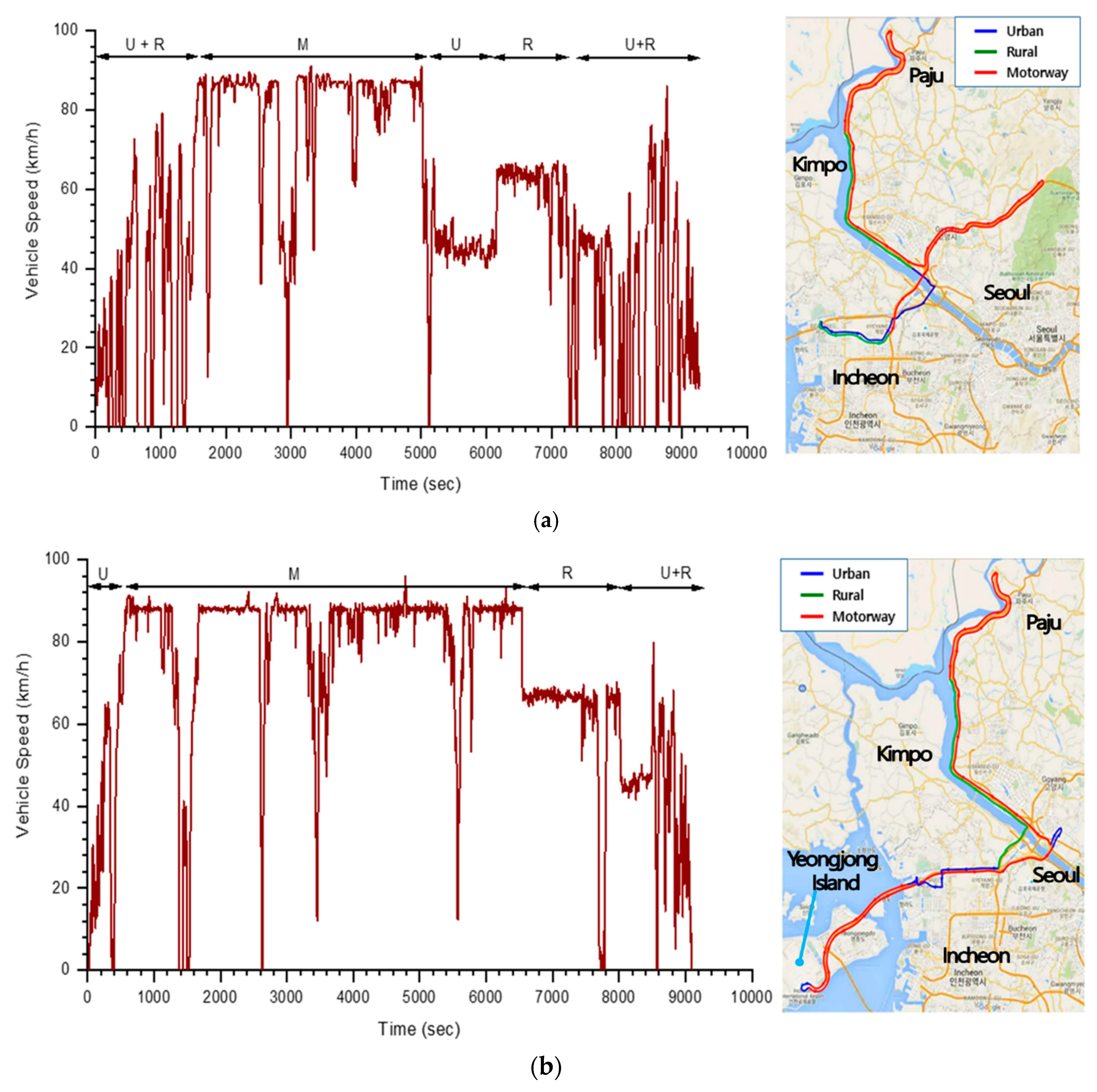
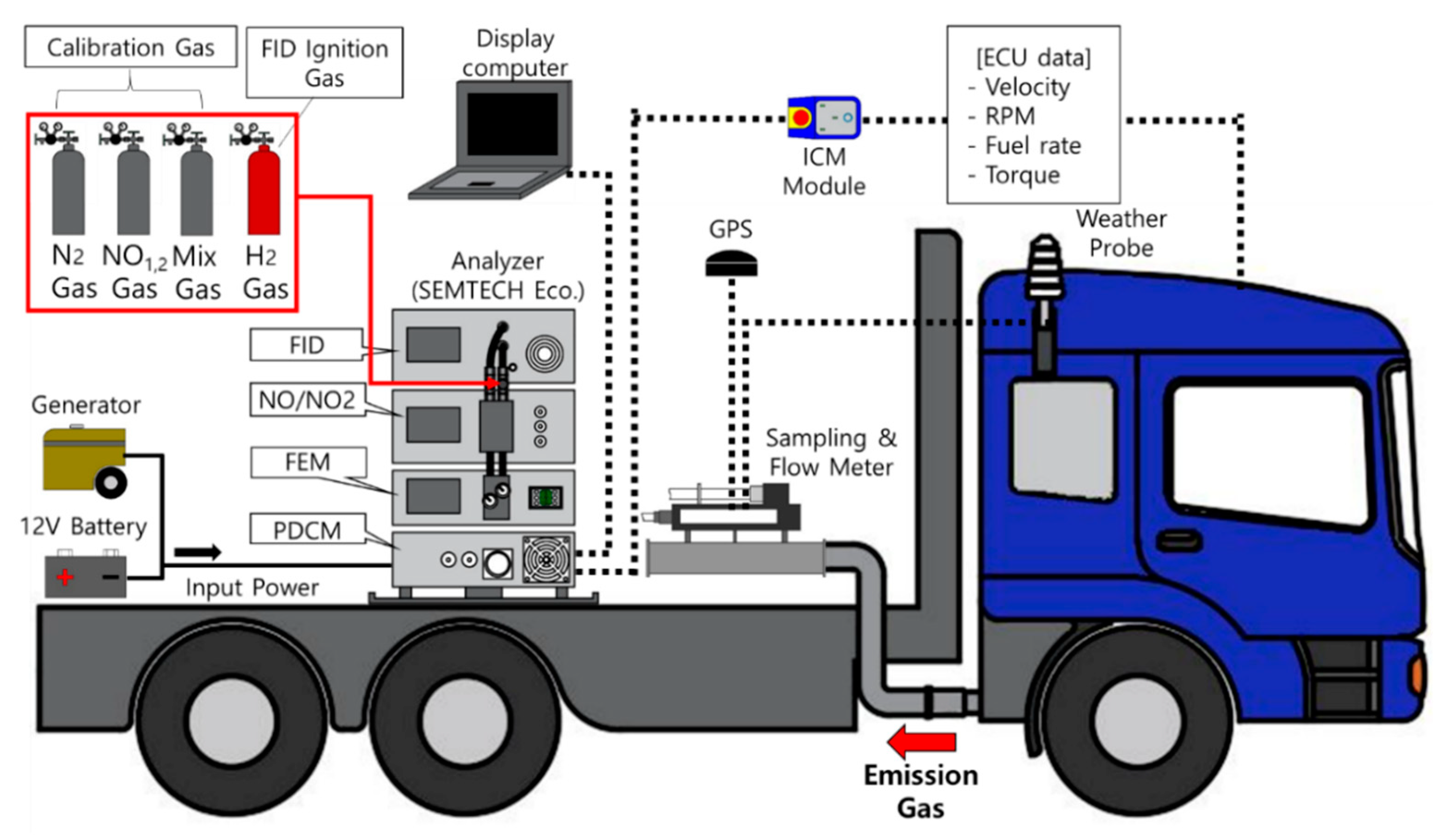

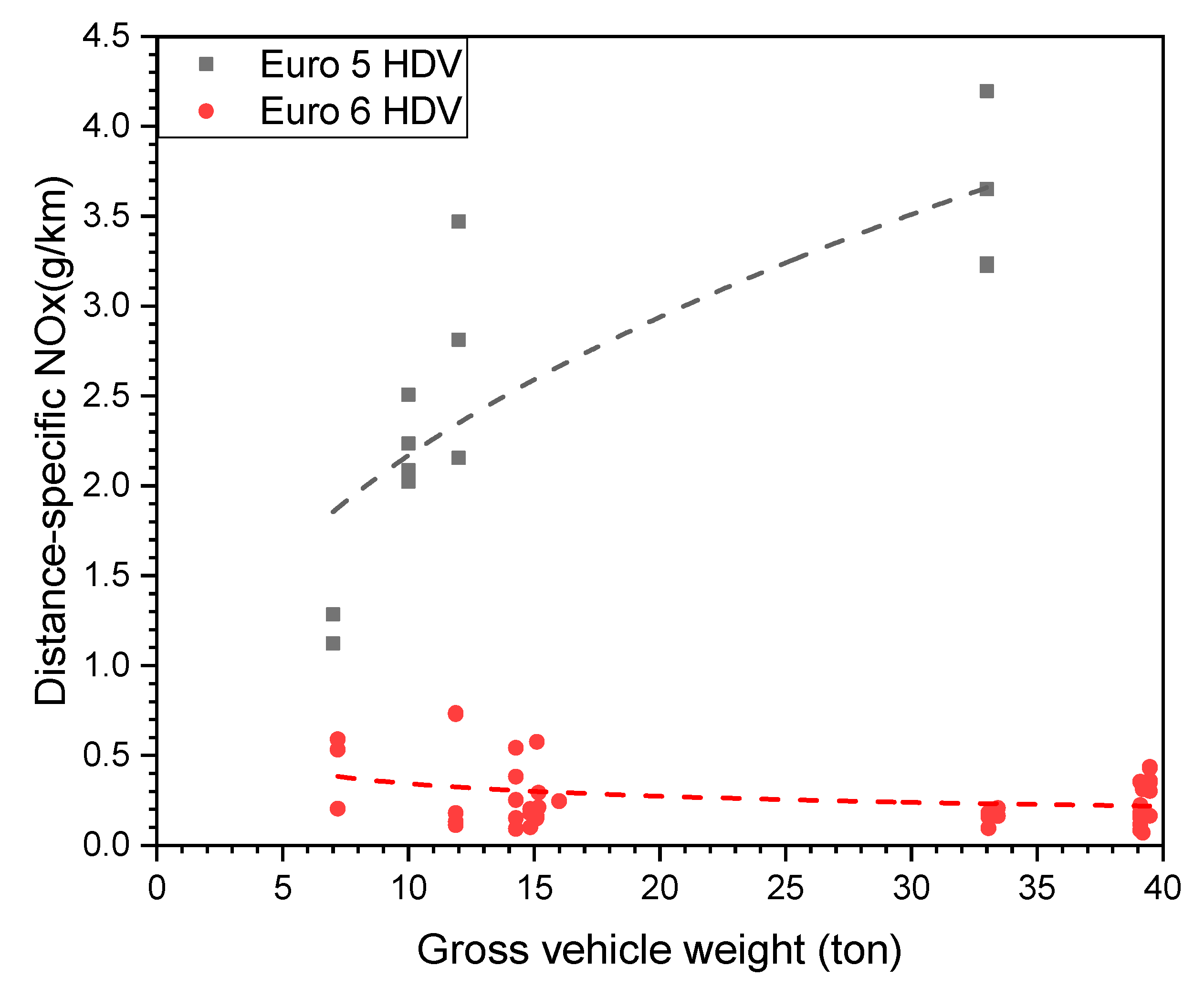
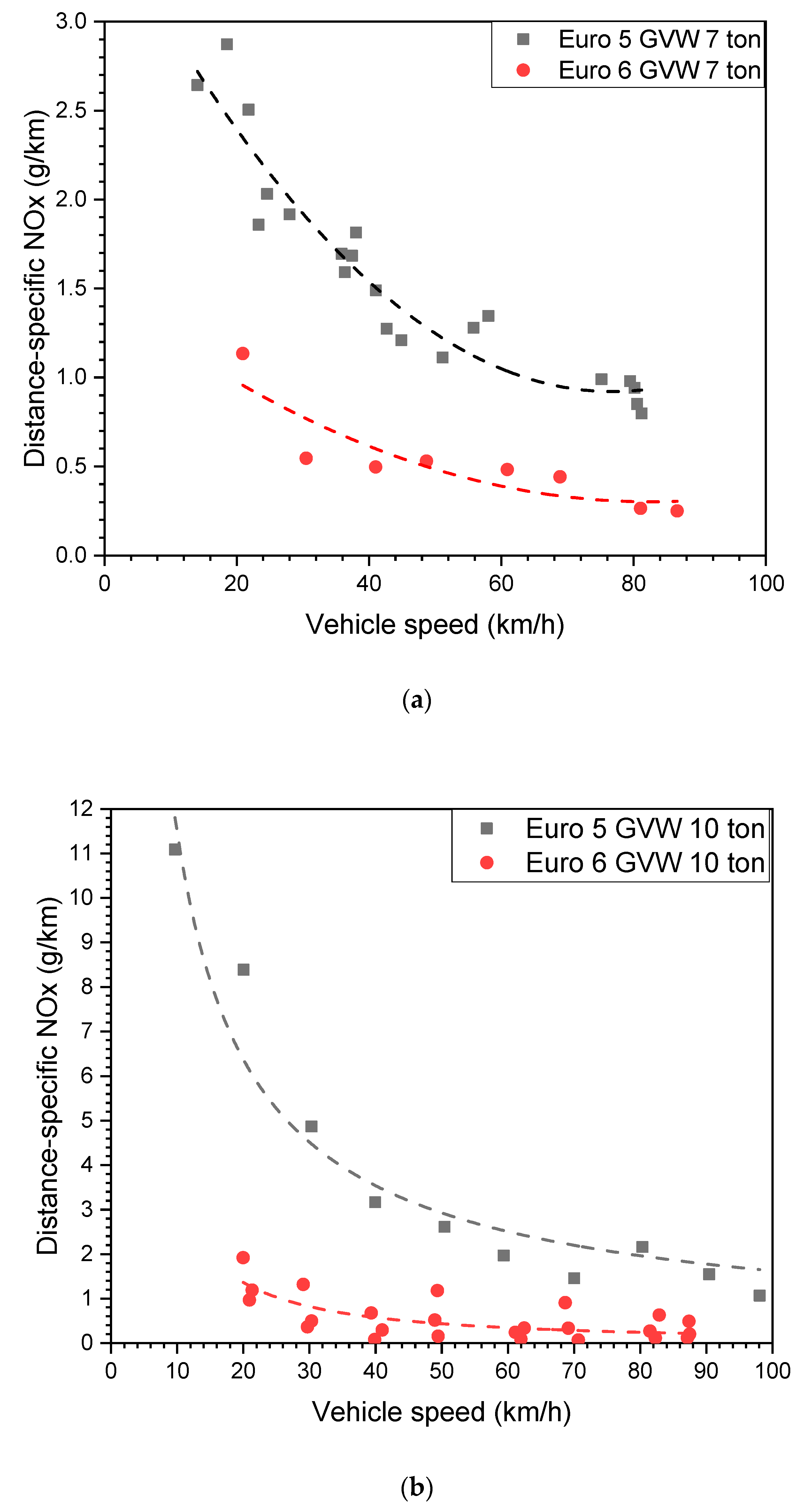

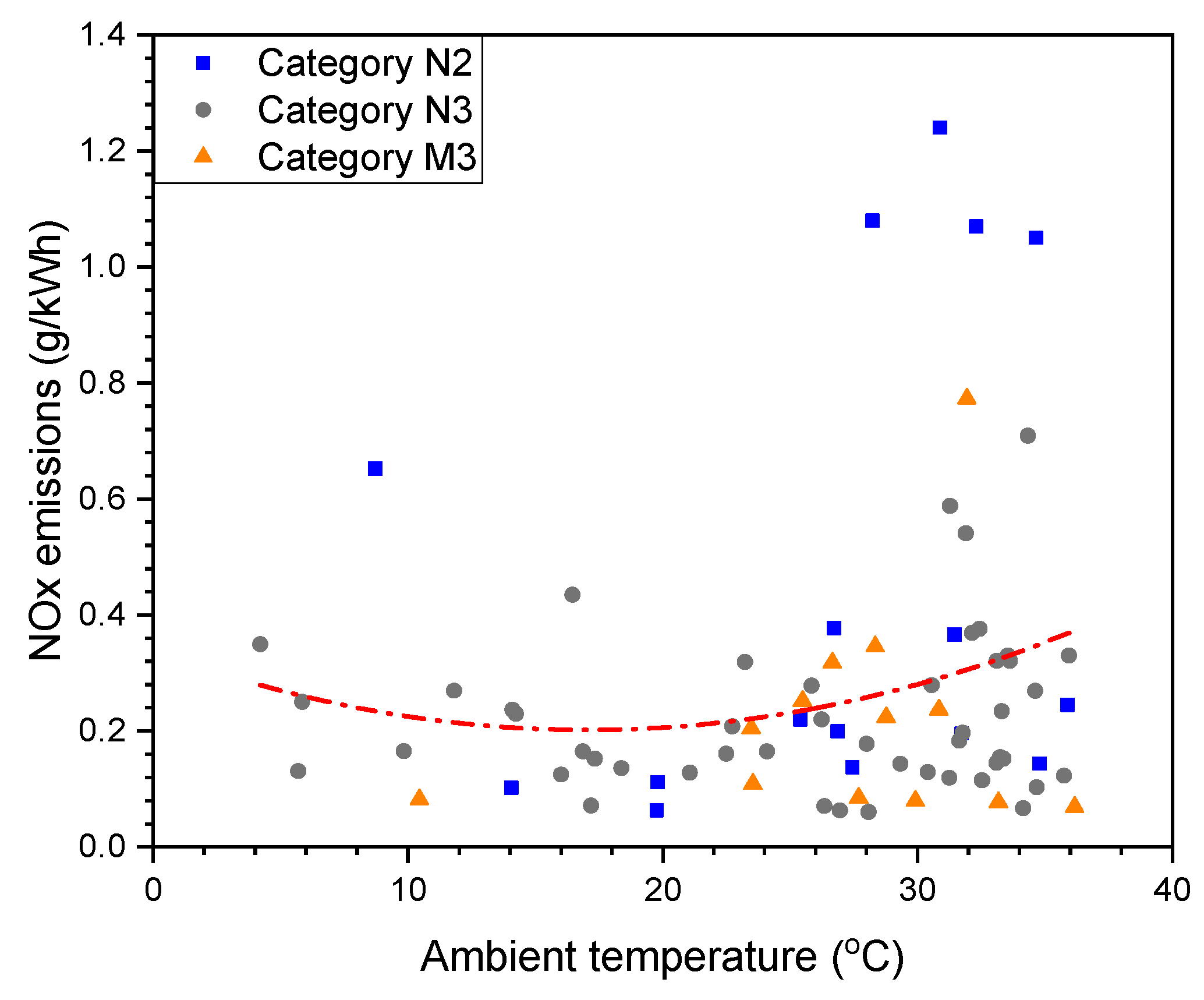
| Emission Regulations | Vehicle Category | Gross Vehicle Weight (Ton) | Driving Work | Driving Route (Trip Shares) | Test Number |
|---|---|---|---|---|---|
| Euro 5 | N2 | 7 | ETC × 3 | (U 4:R 3:M 3) | 2 |
| 10 | 4 | ||||
| N3 | 33 | (U 3:R 2:M 5) | 4 | ||
| M3 | 12 | (U 4:R 3:M 3) | 2 | ||
| Euro 6 step C | N2 | 3.5–7 | WHTC × 5 | route A (U 4.5:R 2.5:M 3.0) | 13 |
| N3 | 7–40 | route B (U 2.0:R 2.5:M 5.5) | 48 | ||
| M3 | 12–16 | 4 |
| Gas Analyzers | Euro 6 Vehicles | Euro 5 Vehicles |
|---|---|---|
| Manufacturer | Sensors Inc. | Horiba |
| Model | Semtech–ECOSTAR | OBS-2200 |
| CO (Measuring range) | NDUV (0–8 vol%) | NDIR (0–10 vol%) |
| THC (Measuring range) | FID (0–30,000 ppm C) | FID (0–10,000 ppm C) |
| NOx (Measuring range) | NDUV (0–3000 ppm) | CLD (0–3000 ppm) |
| Exhaust flow | EFM4 (Pitot flow meter) | Volume sampler |
© 2020 by the authors. Licensee MDPI, Basel, Switzerland. This article is an open access article distributed under the terms and conditions of the Creative Commons Attribution (CC BY) license (http://creativecommons.org/licenses/by/4.0/).
Share and Cite
Ko, S.; Park, J.; Kim, H.; Kang, G.; Lee, J.; Kim, J.; Lee, J. NOx Emissions from Euro 5 and Euro 6 Heavy-Duty Diesel Vehicles under Real Driving Conditions. Energies 2020, 13, 218. https://doi.org/10.3390/en13010218
Ko S, Park J, Kim H, Kang G, Lee J, Kim J, Lee J. NOx Emissions from Euro 5 and Euro 6 Heavy-Duty Diesel Vehicles under Real Driving Conditions. Energies. 2020; 13(1):218. https://doi.org/10.3390/en13010218
Chicago/Turabian StyleKo, Sangchul, Junhong Park, Hyungjun Kim, Gunwoo Kang, Jongchul Lee, Jongmin Kim, and Jongtae Lee. 2020. "NOx Emissions from Euro 5 and Euro 6 Heavy-Duty Diesel Vehicles under Real Driving Conditions" Energies 13, no. 1: 218. https://doi.org/10.3390/en13010218
APA StyleKo, S., Park, J., Kim, H., Kang, G., Lee, J., Kim, J., & Lee, J. (2020). NOx Emissions from Euro 5 and Euro 6 Heavy-Duty Diesel Vehicles under Real Driving Conditions. Energies, 13(1), 218. https://doi.org/10.3390/en13010218





